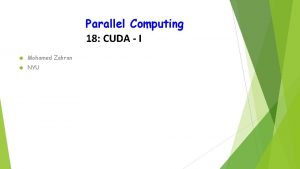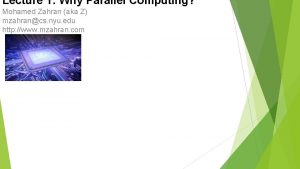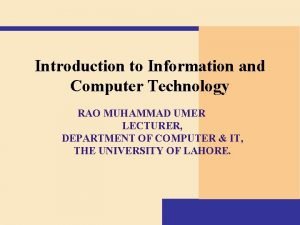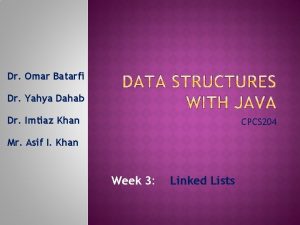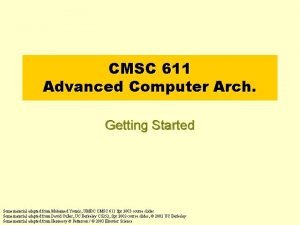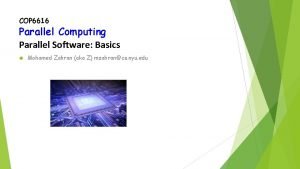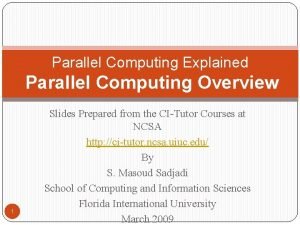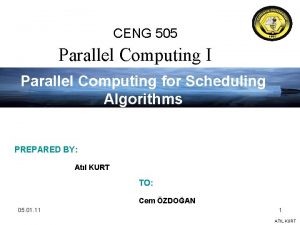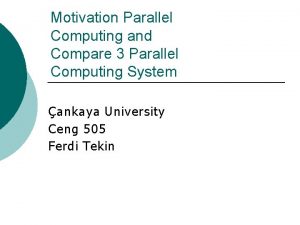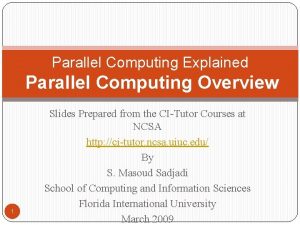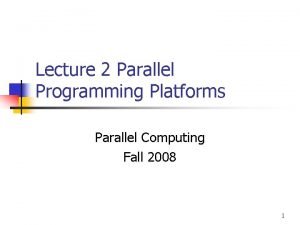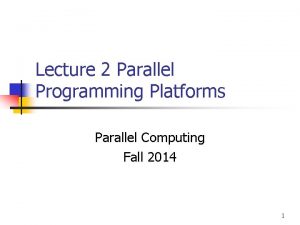Lecture 1 Why Parallel Computing Mohamed Zahran aka




































- Slides: 36

Lecture 1: Why Parallel Computing? Mohamed Zahran (aka Z) mzahran@cs. nyu. edu http: //www. mzahran. com

Main Goals of this Course Why parallel computing is the current and next big thing? How does the parallel hardware look like? What are the challenges of parallel computing? How to write parallel programs and make the best use of the underlying hardware?

My wish list for this course: Learn to think in parallel Make the best choice of hardware configuration and software tools/languages Be ready for the competitive market or for your next step in the academic/research ladder Develop a set of tools

Now, what is this story of parallel computing, multicore, multiprocessing, multi-this and multithat? The Famous Moore’s Law


• • It was implicitly assumed that more transistors per chip = more performance. BUT … ~1986 – 2002 à 50% performance increase Since 2002 à ~20% performance increase Hmmm … Why do we care? 20%/year is still nice. What happened at around 2002? Can’t we have auto-parallelizing programs?

Why do we care? • More realistic games • Decoding the human genome • More accurate medical applications • The list goes on and on ….

As our computational power increases à the number of problems we can seriously consider also increases

Climate modeling

Protein folding

Drug discovery

Energy research

Data analysis

Hardware Improvement Why did we build parallel machines (and continue to do so)? Positive Cycle People ask for more of Computer Better Software improvements Industry People get used to the software

Moore’s law is giving us more transistors than we can afford! Scaling clock speed (business as usual) will not work 10000 Sun’s Surface Rocket Nozzle 1000 ) 2 Power Density (W/cm Power Density Nuclear Reactor 100 8086 Hot Plate 10 4004 8008 8085 386 286 8080 1 486 P 6 Pentium® Source: Patrick

Multicore Processors Save Power = C * V 2 * F Performance = Cores * F Let’s have two cores Power = 2*C * V 2 * F Performance = 2*Cores * F But decrease frequency by 50% Power = 2*C * V 2/4 * F/2 Power = C * V 2/4 * F Performance = 2*Cores * F/2 Performance = Cores * F

A Case for Multiple Processors • • Can exploit different types of parallelism Reduces power An effective way to hide memory latency Simpler cores = easier to design and test = higher yield = lower cost

An intelligent solution Instead of designing and building faster microprocessors, put multiple processors on a single integrated circuit.

Now it’s up to the programmers • Adding more processors doesn’t help much if programmers aren’t aware of them… • … or don’t know how to use them. • Serial programs don’t benefit from this approach (in most cases).

The Need for Parallel Programming Parallel computing: using multiple processors in parallel to solve problems more quickly than with a single processor Examples of parallel machines: A cluster computer that contains multiple PCs combined together with a high speed network A shared memory multiprocessor (SMP) by connecting multiple processors to a single memory system A Chip Multi-Processor (i. e. multicore) (CMP) contains multiple processors (called cores) on a single chip

Attempts to Make Multicore Programming Easy • 1 st idea: The right computer language would make parallel programming straightforward –Result so far: Some languages made parallel programming easier, but none has made it as fast, efficient, and flexible as traditional sequential programming.

Attempts to Make Multicore Programming Easy • 2 nd idea: If you just design the hardware properly, parallel programming would become easy. –Result so far: no one has yet succeeded!

Attempts to Make Multicore Programming Easy • 3 rd idea: Write software that will automatically parallelize existing sequential programs. –Result so far: Success here is inversely proportional to the number of cores!

Parallelizing a sequential program is not very easy! • It is not about parallelizing every step of the sequential program. • Maybe we need a totally new algorithm. • Our parallelization strategy also depends on the software!

Example • Compute n values and add them together. • Serial solution: • We have p cores, p much smaller than n.

Example (cont. ) • Each core performs a partial sum of approximately n/p values. Each core uses it’s own private variables and executes this block of code independently of the other cores.

Example (cont. ) Once all the cores are done computing their private my_sum, they form a global sum by sending results to a designated “master” core which adds the final result.

Example (cont. )

But wait! There’s a much better way to compute the global sum

Better parallel algorithm Don’t make the master core do all the work. Share it among the other cores. Pair the cores so that core 0 adds its result with core 1’s result. Core 2 adds its result with core 3’s result, etc. Work with odd and even numbered pairs of cores.

Better parallel algorithm (cont. ) • Repeat the process now with only the evenly ranked cores. • Core 0 adds result from core 2. • Core 4 adds the result from core 6, etc. • Now cores divisible by 4 repeat the process, and so forth, until core 0 has the final result.

Multiple cores forming a global sum

Analysis • In the first version, the master core performs 7 receives and 7 additions. • In the second version, the master core performs 3 receives and 3 additions. • The improvement is more than a factor of 2.

Analysis (cont. ) • • • The difference is more dramatic with a larger number of cores. If we have 1000 cores: – The first example would require the master to perform 999 receives and 999 additions. – The second example would only require 10 receives and 10 additions. That’s an improvement of almost a factor of 100!!

Two Ways Of Thinking. . . And one Strategy! • Strategy: Partitioning! • Two ways of thinking: – Task-parallelism – Data-parallelism • Some constraints: – communication – load balancing – synchronization

Conclusions • Due to technology constraints, we moved to multicore processors. • Parallel programming is now a must à The free lunch is over! • There are different flavors of parallel hardware that we will discuss and also many flavors of parallel programming languages that we will deal with.
 Mohamed zahran nyu
Mohamed zahran nyu Mohamed zahran nyu
Mohamed zahran nyu Cloud computing lecture
Cloud computing lecture Hey hey bye bye
Hey hey bye bye 01:640:244 lecture notes - lecture 15: plat, idah, farad
01:640:244 lecture notes - lecture 15: plat, idah, farad Cloud computing lecture
Cloud computing lecture Conventional computing and intelligent computing
Conventional computing and intelligent computing Dont ask why why why
Dont ask why why why Riham mohamed aly
Riham mohamed aly Mohamed dahoui
Mohamed dahoui Dr elsayed mohamed
Dr elsayed mohamed Mohamed kossentini
Mohamed kossentini Mohamed homayed death
Mohamed homayed death Mohamed computer technology
Mohamed computer technology Mohamed el merouani
Mohamed el merouani Mohamed seghir nekkache
Mohamed seghir nekkache Mohammad diab md
Mohammad diab md Yahye mohamed omar
Yahye mohamed omar Professor nasser mohamed
Professor nasser mohamed Dr mohamed eldeib
Dr mohamed eldeib Mohamed
Mohamed Bouhicha mohamed
Bouhicha mohamed Abdelrahman mohamed
Abdelrahman mohamed Dr mohamed bashar shala
Dr mohamed bashar shala Dr mohamed bashar shala
Dr mohamed bashar shala Mohamed salah
Mohamed salah Mohamed akel
Mohamed akel Mohamed akel
Mohamed akel Mohamed akel
Mohamed akel Henintsoa georges
Henintsoa georges Mohamed merchant
Mohamed merchant Mohamed akel
Mohamed akel Hassan fareed physics
Hassan fareed physics Mohamed younis umbc
Mohamed younis umbc Mr mohamed chafik el idrissi
Mr mohamed chafik el idrissi Mohamed hmiden
Mohamed hmiden Prophet musa family tree
Prophet musa family tree
